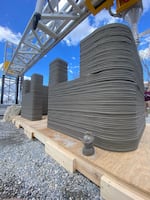Editor’s note: This story is part of a series looking at efforts that communities in Grant County, like other parts of rural Oregon, are taking to attempt to attract and retain workers.

A structure printed with concrete and a 3D printer by manufacturer Alquist.
Courtesy: Alquist
Contractor Josh Walker jumps out of his rig to survey a hilly and steep 81-acre parcel of land he recently bought in John Day for $140,000, a quarter of the price it sold for 15 years ago.
“There are some flat spots that are tucked in throughout the acreage that have lot sites that won’t take incredible excavation on a steep incline,” he said.
The incline isn’t the only reason the land was cheap. Many builders don’t want to take on construction projects in a small high-desert town like John Day because, for similar effort, they can build homes in Bend or Portland that sell for two or three times the price.
But after eight years in the military, Walker wanted to return to his hometown, raise a family and run a construction business.
Initially, he planned to build traditional wood-framed homes on his new land. But then he talked to city leaders, who suggested trying something different — using 3D technology to print homes using a computer, a high-tech pump and quick-setting concrete.
“The thought is that you can come in a single day and get a structure completely printed,” Walker said.
So two construction workers might be able to do in one day what it takes a team of four a whole week to accomplish with traditional methods — and for a much lower price.
So far, builders trying to use the technology have found problems printing things like corners and roofs. The 3D-printed structures that have been built tend to be whimsical demonstration projects — great for Instagram, but not so good as functional homes.
Indeed, getting planning permission for such unproven technology is expensive, in the range of $60,000. That’s another reason 3D-printed homes aren’t popping up everywhere.
To mitigate the logistical challenges, the City of John Day applied for and won a grant from the Oregon Department of Land Conservation and Development. Now Walker and the City of John Day have $60,000 to develop plans for a practical 3D-printed home.
“I mean it’s really a partnership between us and the city and the state to try and figure all of this out,” Walker said.
He hopes to print four separate structures on his land with three living units in each. He’ll then rent them out. The average rent in John Day is about $700 a month, and Walker is not worried about finding tenants.
“People are always looking for rentals,” he said. “When rentals get posted, they’re usually gone in a day or two.”
The $60,000 will be used up by engineers, architects and the like to develop an acceptable design. The rest of the work is financed with a construction loan, just like any other development.
This is very much an experiment, and 3D printing may turn out to be much more expensive, or ugly, or just plain impractical given John Day’s weather and the state’s seismic requirements.
But it’s worth the risk, Walker said. He’s going to build the first four homes no matter what.
“There’ll still be buildings standing there that’ll last for 50 to 100 years or whatever it is. And people will live in them and … It’s not for naught.”
If the 3D homes do work out, John Day city manager Nick Green said the state can use the plans to print inexpensive 3D homes across small-town Oregon, boosting the housing supply. They could even be used to quickly replace homes burned in something like a catastrophic wildfire.

John Day City Manager Nick Green secured a $60,000 grant from the state to create plans for building a practical 3D printed home. He hopes the city will become a hub for 3D printing.
Kristian Foden-Vencil / OPB
Green’s big hope, of course, is that John Day will become a center for 3D home printing — attracting high-paying jobs and boosting the population.
“We’re looking to leapfrog technologies,” Green said. “Go from being the last people to adopt a new innovation, to the ones that are actually the innovation that everyone is parroting.”
3D printing homes might seem like a stretch for a small city. But authorities here are desperate. Over the last two decades, four out of the five timber mills that used to operate in Grant County have closed. That has resulted in a 9% loss in population. And the people who stayed are getting older. More than half of Grant County residents are 55 or older.
“We’ve left half measures behind,” said Green. “When you’re in last place and winning the race to the bottom in every socio-economic category. It’s time to think bold and to go big.”
But how big and bold is the idea?
Chris Rich, the regional economist for Eastern Oregon, said printing 3D houses is an interesting concept and he hopes it works out.
“If we want to try to develop ourselves economically after seeing this decline in the economy and the population over the last couple of decades, then that might need some out-of-the-box thinking,” Rich said.
Not everyone in John Day supports the idea. Some critics say local government shouldn’t be in the business of building homes, even with grant money. Others worry that if 3D printing becomes successful, John Day might suddenly boom like Bend — bringing along the same kind of housing, traffic and homelessness challenges Central Oregon now faces.
Walker rolls his eyes at the idea John Day is about to boom.
“What would it hurt if we gained 1,000 people right now?” he said. “We wouldn’t look like Bend if we gained 1,000 people. But we’ve bled 1,000 people over the last three decades.”
Walker plans to start pumping cement later this year, after which he’ll go over the numbers with the city to see if his 3D home project is an economic success.

Josh Walker and Russ Comer of Mahogany Ridge Properties have big plans for 81 acres of John Day land they recently bought. They'll build regular timber framed homes, but they're also going to try 3D printing some.
Kristian Foden-Vencil / OPB
